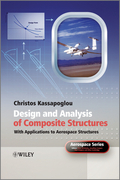
Design and analysis of composite structures: with applications to aerospace structures
Kasapoglou, Christos
Design and Analysis of Composite Structures enables graduate students and engineers to generate meaningful and robust designs of complex composite structures. Combining analysis and design methods for structural components, the book begins with simple topics such as skins and stiffeners and progresses through to entire components of fuselages and wings. Starting with basic mathematical derivation followed by simplifications used in real-world design, Design and Analysis of Composite Structures presents the level of accuracy and range of applicability of each method. Examples taken from actual applications are workedout in detail to show how the concepts are applied, solving the same design problem with different methods based on different drivers (e.g. cost or weight)to show how the final configuration changes as the requirements and approach change INDICE: "Preface 1. Applications of advanced composites in aircraft structures References 2. Cost of Composites- A qualitative discussion 2.1 Recurring cost 2.2 Non-recurring cost 2.3 Technology selection 2.4 Summary and conclusions Exercises References 3. Review of Classical Laminated-Plate Theory 3.1 Composite Materials - Definitions, symbology and terminology 3.2 Constitutive equations in three dimensions 3.3 Constitutive equations in two dimensions - Planestress Exercises References 4. Review of laminate strength and failure criteria 4.1 Maximum stress failure theory 4.2 Maximum strain failure theory 4.3 Tsai-Hill failure theory 4.4 Tsai-Wu failure theory 4.5 Other failure theories References 5. Composite structural components and mathematical formulation 5.1 Overview of composite airframe 5.2 Governing equations 5.3 Reductions of governing equations - Applications to specific problems 5.4 Energy methods ExercisesReferences 6. Buckling of composite plates 6.1 Buckling of rectangular composite plate under biaxial loading 6.2 Buckling of rectangular composite plate under uniaxial compression 6.3 Buckling of rectangular composite plate under shear 6.4 Buckling of long rectangular composite plates under shear 6.5 Buckling of rectangular composite plates under combined loads 6.6 Design equations for different boundary conditions and load combinations Exercises References 7. Post-buckling 7.1 Post-buckling analysis of composite panels under compression 7.2 Post-buckling analysis of composite plates under shear Exercises References8. Design and analysis of composite beams 8.1 Cross-section definition based on design guidelines 8.2 Cross-sectional properties 8.3 Column buckling 8.4 Beam on elastic foundation under compression 8.5 Crippling 8.6 Importance of radius regions at flange intersections 8.7 Inter-rivet buckling of stiffener flanges 8.8 Application - Analysis of stiffener in a stiffened panel under compression Exercises References 9. Skin-stiffened structure 9.1 Smearing of stiffness properties (equivalent stiffness) 9.2 Failure modes of a stiffened panel 9.3Additional considerations of stiffened panels Exercises References 10. Sandwich structure 10.1 Sandwich bending stiffness 10.2 Buckling of sandwich structure 10.3 Sandwich wrinkling 10.4 Sandwich crimping 10.5 Sandwich intra-cellularbuckling (dimpling) under compression 10.6 Attaching sandwich structures Exercises References 11. Good Design practices and Design ""rules of thumb Exercises References Index "
- ISBN: 978-0-470-97263-2
- Editorial: John Wiley & Sons
- Encuadernacion: Cartoné
- Páginas: 328
- Fecha Publicación: 24/09/2010
- Nº Volúmenes: 1
- Idioma: Inglés
